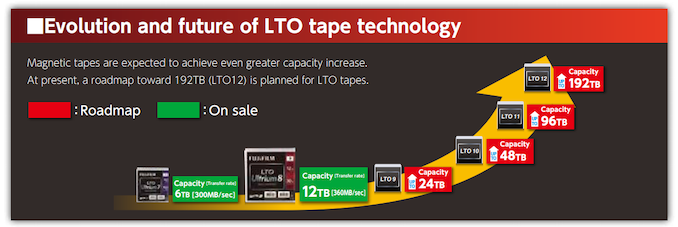400 TB Storage Drives In Our Future: Fujifilm
by Dr. Ian Cutress on June 30, 2020 8:00 AM EST
One of the two leading manufacturers of tape cartridge storage, FujiFilm, claims that they have a technology roadmap through to 2030 which builds on the current magnetic tape paradigm to enable 400 TB per tape.
As reported by Chris Mellor of Blocks and Files, Fujifilm points to using Strontium Ferrite grains in order to enable an areal data density on tape of 224 Gbit-per-square-inch, which would enable 400 TB drives. IBM and Sony have already demonstrated 201 Gbit-per-square-inch technology in 2017, with a potential release of the technology for high volume production in 2026. Current drives are over an order of magnitude smaller, at 8 Gbit-per-square-inch, however the delay between research and mass production is quite significant.
Strontium Ferrite would replace Barium Ferrite in current LTO cartridges. Strontium sits on a row above Barium in the periodic table, indicating a much smaller atom. This enables for much smaller particles to be placed into tracks, and thankfully according to Fujifilm, Strontium Ferrite exhibits properties along the same lines as Barium Ferrite, but moreso, enabling higher performance while simultaneously increasing particle density.
In standard LTO nomenclature, we are currently on LTO-8 where the drives have 12 TB raw capacity. Recent generational increases in LTO tend to double the capacity, so we’re looking at LTO-13 for 384 TB drives. Mellor indicates that there seems to be an average 2.5 years between commercialization of successive LTO drive standards, which leads to the following table:
| LTO Generation Progression | |||||||
| AnandTech | Standard | Retail | Length | Raw Cap. |
Speed MB/s |
Time to fill |
Material |
| LTO-1 | 2000 | 609 m | 0.1 TB | 20 | 1h23 | MP | |
| LTO-2 | 2003 | 609 m | 0.2 TB | 40 | 1h23 | MP | |
| LTO-3 | 2005 | 680 m | 0.4 TB | 80 | 1h23 | MP | |
| LTO-4 | 2007 | 820 m | 0.8 TB | 120 | 1h51 | MP | |
| LTO-5 | 2010 | 846 m | 1.6 TB | 140 | 3h10 | MP | |
| LTO-6 | 2012 | 846 m | 2.5 TB | 160 | 4h20 | MP/BaFe | |
| LTO-7 | 2010 | 2015 | 960 m | 6.0 TB | 300 | 5h33 | BaFe |
| LTO-8 | 2010 | 2017 | 960 m | 12.0 TB | 360 | 9h16 | BaFe |
| LTO-9 | 2014 | 2020 | 24.0 TB | *708 | *9h25 | BaFe | |
| LTO-10 | 2014 | *2022 | 48 TB | *1100 | *12h07 | Ba/Sr Fe | |
| LTO-11 | 2017 | *2025 | 96 TB | *1800 | *14h49 | SrFe | |
| LTO-12 | 2017 | *2027 | 192 TB | *2400 | *22h13 | SrFe | |
| LTO-13 | *2021 | *2030 | *384 TB | SrFe? | |||
| LTO-14 | *2021 | *768 TB | |||||
| *Unconfirmed/estimated | |||||||
Current generation LTO-8 cartridges take at least 9h16 to fill, with predicted speeds on future drives increasing that even further. Current LTO specifications go up to LTO-12, and so 400 TB would thus come in the LTO-13 generation.
Fujifilm states that 400 TB is the limit of Strontium Ferrite, indicating that new materials would be needed to go beyond. That said, we are talking about only 224 Gbit-per-square-inch for storage, which compared to mechanical hard disks going beyhind 1000 Gbit-per-square-inch today, there would appear to be plenty of room at the top if the technologies could converge.
Prices for current LTO-8 tape are the lowest out of all storage media. Depending on volume, prices around 0.8-1 cent per gigabyte is fairly common. Currently only Sony and Fujifilm are licencees to create LTO-8 media, however other companies such as HPE and IBM resell models under their own brand.
Source: Blocks and Files












32 Comments
View All Comments
nandnandnand - Tuesday, June 30, 2020 - link
Nice to see raw capacity being quoted and not compressed.We could use a better form of storage technology for >100 TB. Probably optical-based, hopefully rewritable. Tape, HDD, and NAND all have annoying downsides. Yes, even some consumers/home users could use a 100 TB or larger drive.
Simen1-Norge - Tuesday, June 30, 2020 - link
At 224 Gbit/inch the bits are as small as 54 nm. Optical based technologies must have a wavelength of that order to get those densities. 54 nm is extreme UV light that would etch away most materials, not to mention how hard it would be to focus that light. You simply cant have a UV immersion lithography medium for storage. A reader would cost millions and be as large as a car. The optical storage futurism scifi had its last moments with the remake of the Tron movie.Sorry for destroying a good scifi fantasy with boring reality.
Zizy - Tuesday, June 30, 2020 - link
True, optical storage is not viable in 2D. But it is still a viable 3D contender. There is just a tiny little problem of making it :DSimen1-Norge - Tuesday, June 30, 2020 - link
Tape already are 3D. Think of it as a 3D cylinder, where you roll off thin 2D sheets to another 3D cylinder. The 2D tape layers are stacked at an incredable 5,6 micron thickness. Each LTO cartridge containing a total of over 24 square meters of 2D tape surface. Optical media are not even close in density or effective storage surface areaKamen Rider Blade - Wednesday, July 1, 2020 - link
Optical still has better random access performance =DGuspaz - Tuesday, June 30, 2020 - link
It is, though. Sony ODA (Optical Disc Archive) cartridges hold 5.5TB per cartridge with gen 3. Each cartridge holds eleven discs of 500GB each. They started out using Bluray for the first few revisions, which tops out at 200GB per disc with a double-sided triple-layer rewritable BDXL. They then moved on to Archival Disc, which initially held 300GB per double-sided triple-layer disc, and currently holds 500GB per double-sided triple layer disc. The next generation of disc will hold 1TB per double-sided triple-layer disc, getting them 11TB per ODA cartridge. They're still using the same basic structure/laser/etc from bluray.Density is lower than tape, but there are other advantages, such as longevity. You'll never see an ODA or an Archival Disc in the consumer market.
Kamen Rider Blade - Wednesday, July 1, 2020 - link
I still think it's complete BS that their "Archival Discs" are only limited to 3x layers when in BluRay, they got all the way to 4x layers. They should be able to get to 4x layers with "Archival Disc" density. They already "Double-Side" the bloody thing, why not get 4x layers on both sides.LiKenun - Thursday, July 2, 2020 - link
The price is not too bad for Sony’s Optical Disc Archive. There are some outlets where consumers can pick them up like B&H.I do wonder how they plan to expand the capacity further though. The cartridges use the UDF file system which has been fixed to 2 KiB sectors. The standard uses 32-bit integers to address sectors, giving just under 8 TiB of addressable capacity. If the capacity doubles again, they’d have to update the standard to allow for 4 KiB sectors (probably backwards compatible with some UDF implementations), bring in 64-bit sector addressing (definitely incompatible), or design a whole new file system from scratch.
Kamen Rider Blade - Sunday, July 5, 2020 - link
The ODA drive units are Multi $1,000 units. That's not "Affordable" to the average consumer in any way shape or form.Simen1-Norge - Tuesday, June 30, 2020 - link
That said, I would love to have much cheaper LTO-6-8 writers. LTO-6 media (2,5 TB raw) cost less then 25 USD.